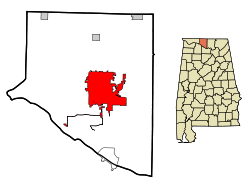Athens, Alabama
| Athens, Alabama | |
|---|---|
| City | |
| City of Athens | |

Limestone County Courthouse in Athens
|
|
 Location in the state of Alabama, USA |
|
| Coordinates: 34°47′23″N 86°58′10″W / 34.78972°N 86.96944°W | |
| Country | United States |
| State | Alabama |
| County | Limestone |
| Incorporated | November 19, 1818 |
| Government | |
| • Type | Mayor Council |
| • Mayor | William R. Marks |
| • City Council |
Members' List
|
| Area | |
| • Total | 39.4 sq mi (102.1 km2) |
| • Land | 39.3 sq mi (101.9 km2) |
| • Water | 0.1 sq mi (0.2 km2) |
| Elevation | 798 ft (243.1 m) |
| Population (2013) | |
| • Total | 24,000 |
| • Density | 610/sq mi (240/km2) |
| Time zone | CST (UTC-6) |
| • Summer (DST) | CDT (UTC-5) |
| ZIP code | 35611-35614-35613 |
| Area code(s) | 256, 938 |
| FIPS code | 01-02956 |
| GNIS feature ID | 0113266 |
| Website | www |
Athens is a city in Limestone County, in the State of Alabama. As of the 2010 census, the population of the city is 21,897. The city is the county seat of Limestone County and is included in the Huntsville-Decatur Combined Statistical Area.
Founded in 1818 by John Coffee, Robert Beaty, John D. Carroll, and John Read, Athens is one of the oldest incorporated cities in the State of Alabama, having been incorporated one year prior to the state's admittance to the Union in 1819. Limestone County was also created by an act of the Alabama Territorial Legislature in 1818. The town was first called Athenson, but was incorporated as Athens after the ancient city in Greece. The town's first mayor was Samuel Tanner, and the Tanner area, south of Athens, was named on his behalf.
The Athens area was the home of William Wyatt Bibb, the first Governor of Alabama, and its second Governor, his brother Thomas Bibb, who succeeded him in office when he died in a fall from his horse.
In 1822, local residents purchased 5 acres (20,000 m2) of land and constructed a building to house the Athens Female Academy. The school became affiliated with the Methodist church in 1842, and was eventually renamed Athens Female College. After becoming coeducational in 1932, the school changed its name again to Athens College. After being taken over by the State of Alabama in 1974, the college was converted to a “reverse junior college,” offering the last two years of instruction for graduates of area community colleges. It is today known as Athens State University.
Many homes in the central part of modern Athens date to the antebellum period, and are part of historic preservation districts.
...
Wikipedia
